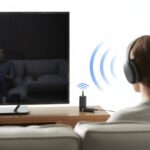Isn’t it wild when you crank the volume all the way up on your Bluetooth headphones and still feel like you’re whispering with your music? We expect booming beats, but sometimes we just get soft lullabies instead.
Bluetooth headphones can sound too quiet for all sorts of reasons—software settings, device limits, or even issues with the headphones themselves.

We’ve all been there—tapping the volume button over and over, hoping our headphones will finally get the message. Maybe the enhancements are acting up, cables or connections aren’t secure, or your phone’s hiding some secret settings that keep things quiet, like those “Absolute Volume” controls that need wrangling.
If your headphones are suddenly too quiet, you’re definitely not alone. It happens to a lot of us (why headphones are so quiet).
Let’s try to untangle these silent problems and see if we can pump up the volume without buying new gear or yelling at our devices.
Common Reasons Bluetooth Headphones Sound Too Quiet
Most of us expect our headphones to pump out some solid sound, but sometimes, all we get is a quiet whisper. Volume settings we forgot about, media that’s oddly quiet, and sneaky app features changing our sound can all play a role.
Low Volume Settings
Let’s be honest, we’ve all frantically jabbed the volume button, convinced our headphones are broken, only to realize the real culprit is hiding somewhere in our device’s settings.
Sometimes your phone and headphones each have their own volume controls—a double whammy. If you only turn up one and not the other, things can stay quiet.
It gets trickier on some devices, where the media and call volumes are separate. You might turn up one volume bar and only end up making the notification sounds louder, while your music stays a mumble.
There’s also something called “Absolute Volume,” which tries to keep the phone and headphone volumes synced. But sometimes, Bluetooth volume gets stuck and doesn’t work right, making things too quiet even at max.
Sometimes just turning Bluetooth off and back on, or giving everything a reboot, brings the noise back.
Incompatible Media Types
Not all music and videos are created equal. Some files or streams are just naturally quieter, and our headphones can only amplify so much.
Ever switched songs and gone from ear-blasting rock to soft jazz that you can barely hear? That’s not your ears playing tricks; it’s just differences in audio mastering or file compression.
Older files or downloaded tracks might have lower bitrates, which can sound weaker—especially over Bluetooth. Some videos or audio from websites are just recorded with lower volume, and not even our headphone’s superpowers can save them.
Certain formats might technically be supported by our headphones, but not handled very well. This can lead to low audio or even muffled sound.
It helps to test our headphones with a variety of songs and videos to see if it’s just one type of media that’s going silent.
App Settings Affecting Volume
Sometimes we forget that our favorite apps are plotting against us—well, at least when it comes to volume. Music and video apps often have their own volume sliders buried in their menus.
We might think we’ve got the volume maxed, but Spotify or YouTube is quietly playing at half power.
A few apps have special sound enhancements, like “Sound Normalization” or “Volume Limiter,” that keep things from getting too loud. That’s great for our ears—but not so great if we actually want to hear the words to the song.
Game and chat apps can also lower the volume automatically, so the in-game voices or calls don’t get drowned out.
If you keep having trouble, it’s worth digging into those app settings and switching off any volume limiters or “quiet mode” features you find. Often, just toggling these off gets your headphones back to full power.
How Volume Control Impacts Audio Levels
When Bluetooth headphones whisper instead of roar, they usually haven’t lost their voice. It often comes down to how our devices handle volume control and sneaky software settings that love to hide in plain sight.
Device Volume Sync Issues
Ever notice how messing with the phone’s volume doesn’t always match what you hear through your headphones? That’s because some devices keep their own volume setting, totally separate from the headphones.
Your phone might be at full blast, but the headphones are barely mumbling. Bluetooth sometimes forgets to sync these up.
On many phones, the device volume and headphone volume act like moody twins who don’t always talk to each other. This can make the sound much quieter than we expect.
To fix it, some phones have a setting called “Absolute Volume” that you can turn on or off, letting both sides agree on how loud is loud enough.
If all else fails, unplug and reconnect or try the volume buttons on both devices. We’re basically mediating for our stubborn gadgets.
Fixing sync issues is a must before blaming the headphones for any lack of volume excitement. If you want more details, you can see how users face this problem and adjust their settings on places like Reddit.
Hidden Volume Limiters
Sometimes our headphones are soundproofed by secret agents—also known as volume limiters. These are built-in features to protect our ears but end up protecting us from hearing anything at all.
Phones and headphones can both have max volume caps hiding in their menus. Your device might have a “Volume Limiter” or “Safe Listening” mode, especially if it’s looking out for your long-term hearing.
These are supposed to keep volume under control, but sometimes they’re so cautious that even at max settings, you can barely enjoy your music.
To crack this secret code, check all sound settings. Look for anything that says “limit,” “safe,” or “protection.” Adjust or turn them off and test again.
For more step-by-step guidance on overcoming these hidden controls, check out the instructions here.
You might finally get your headphones to stop whispering and start singing.
Troubleshooting Your Bluetooth Headphones
When Bluetooth headphones start acting up, it’s tempting to just yell at them. But before we blame the headphones for ruining our latest dance party, let’s cover two big things: keeping software up to date and knowing when it’s time to give the headphones a little TLC.
Check for Product Updates
Yeah, technology is needy. But sometimes, the only thing standing between us and crisp sound is a quick update.
Manufacturers love to release firmware and app updates. Skipping these is basically telling our headphones that we’re fine with low volume and random glitches.
Let’s embrace the fun of checking for updates:
- Grab your phone or computer and make sure the operating system is also up to date.
- Visit the headphone brand’s website or app. That’s where updates hide.
- Look for any firmware update options. If you see “update available,” hit it like you’re smashing a like button.
- Wait for the process to finish. If the connection drops halfway, your headphones might stage a protest. Just restart the process.
Some updates fix known volume or Bluetooth issues, so this tiny chore often works wonders.
A fresh update can make your headphones feel brand new—without actually buying a new pair. That’s pretty satisfying, right?
Service Your Product
Alright, if your headphones are still quieter than a library, it might be time for a little hands-on attention. No, you’re not building a robot. You’re just fixing what you can and knowing when to call in the experts.
Let’s start simple:
- Check for dust or earwax in the headphone speakers.
- Use a soft brush or cotton swab to gently clean the grills. Your headphones will thank you—or at least, they’ll sound better.
- Try connecting the headphones to another device. If they’re still quiet, it’s probably not your phone’s fault.
If none of that helps, it might be time to contact customer support. Many companies have solid warranty policies or service centers.
Alternatively, if you feel like Bluetooth headphone surgeons at heart, look for official repair guides or service options on the brand’s website. Sometimes, headphones need a professional touch to get that volume back up—because nobody should have to listen to their favorite song at whisper-level.
If you’re still curious, there are more tips on fixing quiet headphones.
App and Streaming Service Audio Settings
Sometimes, the reason our Bluetooth headphones sound quiet isn’t the headphones at all. The real culprit may be hiding in our favorite apps and streaming services, quietly turning down the volume when we least expect it.
Adjusting Settings in Streaming Music Services
We’ve all been there—bopping along to our playlist, thinking our headphones are broken, but it turns out Spotify or Apple Music simply has the audio turned way down.
Many music apps come with their own volume control, which is separate from our phone’s main volume. When we ignore this sneaky setting, our music just won’t get loud enough.
Some apps have Soundcheck or Normalization features that try to keep each song at the same volume. This is nice if you hate sudden jumps in music loudness, but it can make everything a bit softer.
If you want things louder, check if these options are switched on, and try turning them off.
You can also look for equalizer presets with names like “Late Night” or “Reduce Loud Sounds.” These are designed for comfort but can make your music sound faint.
For a quick fix, try setting the equalizer to “Off” or choose a setting like “Loudness” if it exists in your app.
For more detailed steps for Apple users, check this Apple Communities discussion.
Different Experiences With Podcasts
Podcasts really are their own adventure. Some episodes come from pros in slick studios, but others? Well, they sound like someone recorded them on a phone in a wind tunnel. The volume can jump all over the place—not just from show to show, but sometimes even within a single episode.
Most podcast apps toss in their own audio tricks, like volume boost, silence trimming, and voice enhancement. If a favorite show sounds too quiet, it’s worth poking around in those settings. Sometimes there’s a “Volume Boost” switch just waiting to help.
Watch out for podcast apps that automatically compress or equalize the sound. These features sometimes make the host’s voice way quieter than it should be. Not every app gets it right, so it pays to explore what yours can do before blaming your headphones for everything.
Audio Quality and Bass Performance
Bluetooth headphones can fool us into thinking they’re just too quiet, when really, they’re holding back on the sound. Usually, the real problem is weak bass or unbalanced audio, not just a low volume setting.
How Bass Affects Perceived Volume
Let’s be real—no one buys headphones hoping for a wimpy thump in their playlists. When the bass is weak, everything sounds quieter, even if the volume’s maxed out. Good bass fills out the music and makes every beat hit harder.
If the headphones suddenly lose bass, the sound gets flat and lifeless. This happens pretty often with some Bluetooth models, and it might mean the settings or connection aren’t quite right. Bad connections or damaged cables can turn your favorite tracks into background noise.
Headphones can also sound quieter if the bass drops out because of dust in the drivers or one side not working properly. If the punch is gone, it’s probably not just your imagination—it could be a real bass issue.
Less Common Causes of Quiet Sound
Sometimes Bluetooth headphones just want to make things weird. When the usual fixes don’t work, it’s time to check out those less obvious reasons your tunes are barely whispering.
Interference and Signal Issues
Bluetooth headphones love connecting to all sorts of devices, but they’re not fans of crowded radio signals. If you’re surrounded by Wi-Fi routers, microwaves, or a dozen other Bluetooth gadgets, your headphones might struggle. This electronic chaos can mess with the connection and make the sound drop or get super quiet. The farther you wander from your device, the weaker the Bluetooth handshake gets.
If you think interference is the culprit, try moving to a new spot—maybe not right next to the Wi-Fi router. Sometimes just turning off nearby Bluetooth devices does the trick. Bluetooth 4.0 and newer usually handle interference better, but even they can’t save you from the madness of a packed coffee shop, where signals are everywhere.
Physical Obstructions
Walls, metal desks, and even your own body (yep, you can block your own music) can weaken Bluetooth signals. Unlike snacks that magically appear on the couch, Bluetooth needs a pretty clear path. If you stash your phone in a backpack or under laundry, don’t be surprised if the sound drops or cuts out.
Common obstacles include metal doors, thick walls, fridges, and crowds of people between your device and your ears. You can help your headphones by keeping the audio source close, or by moving stuff out of the way—though maybe don’t start a home makeover just for better sound.
If you think physical barriers are making things too quiet, try this: hold your phone in your hand, step into an open space, and see if the volume jumps from “barely there” to “living room dance party.”
Final Tips for Louder Listening
When you’re wrestling with quiet Bluetooth headphones, try to boost the volume safely and smartly. Cranking it to the max isn’t always the answer—our ears, sadly, don’t come with a reset button.
Safe Listening Practices
Let’s be honest, it’s tempting to crank up the volume until we can feel the bass from the hallway. Still, experts usually recommend keeping headphone volume under 60% to protect our hearing.
That’s not just a safety thing—it can actually help our headphones last longer. Who wants to keep buying new ones every few months?
Try following the 60/60 rule: listen at 60% volume for no more than 60 minutes at a time. Our ears definitely deserve a break now and then.
If your headphones seem too quiet, check the connections and device settings. Sometimes, it’s just a loose wire or a glitchy jack.
Honestly, it might be time for a better pair if you’re always fiddling with the volume. Damaged parts can really kill the sound, as this troubleshooting guide points out.
Also, maybe don’t mess with the built-in volume caps on your phone or music player. Those limits exist for a reason, right?
No song is worth risking your hearing forever.
- Why is my fitness tracker not pairing with Apple Health? Troubleshooting for Technologically Cursed Mortals - December 22, 2025
- Why is my fitness tracker not updating firmware? Tech Tantrums and Update Woes Explained - December 21, 2025
- Why is the Sound Quality on My Bluetooth Headphones Poor? It’s Not Just Bad Music Taste! - December 21, 2025






